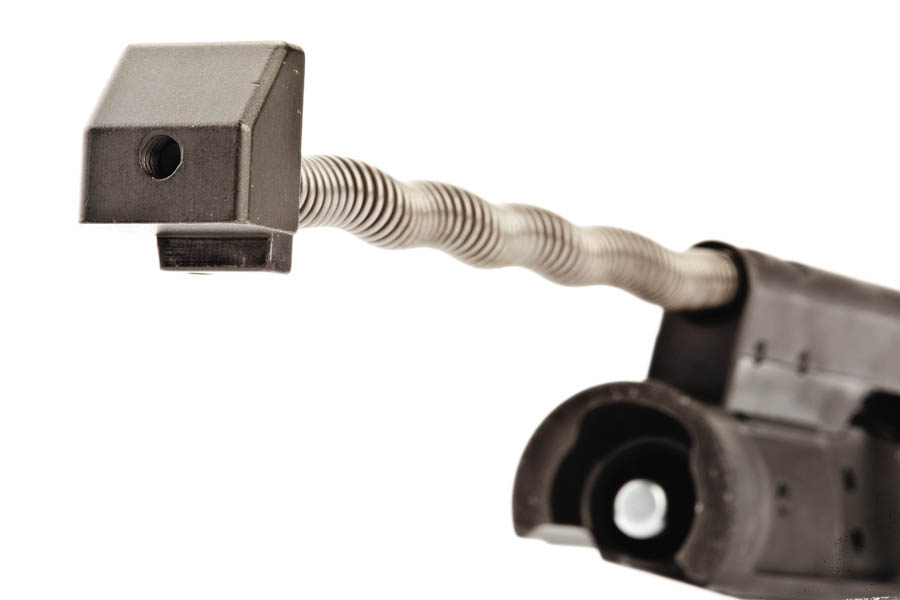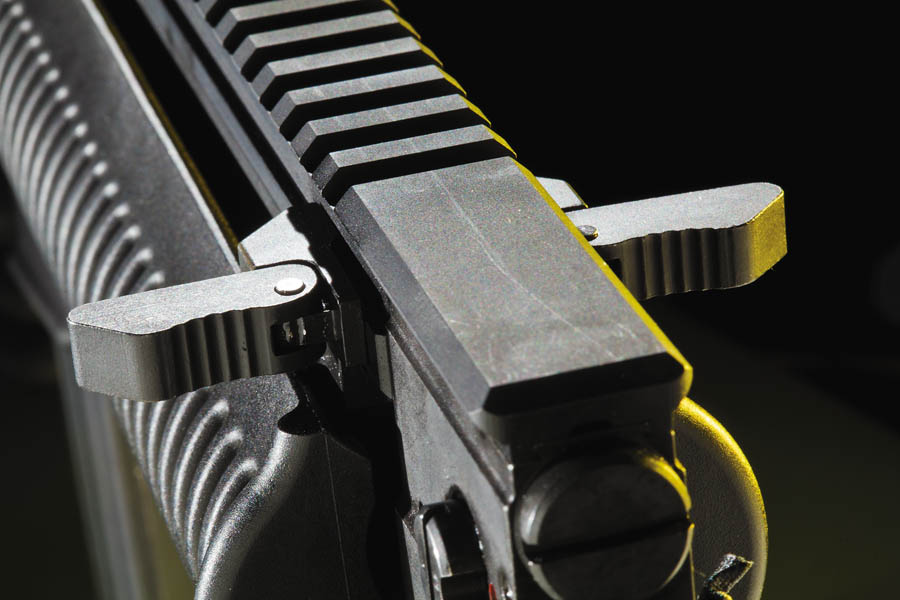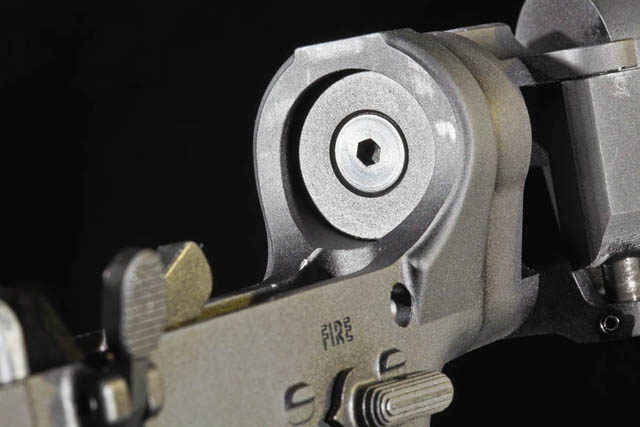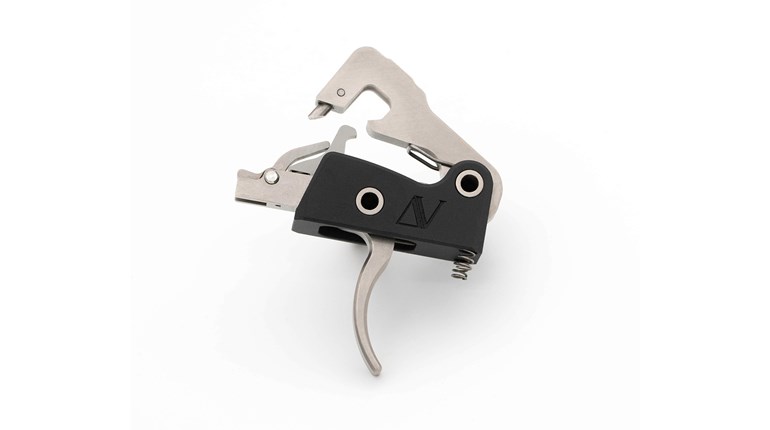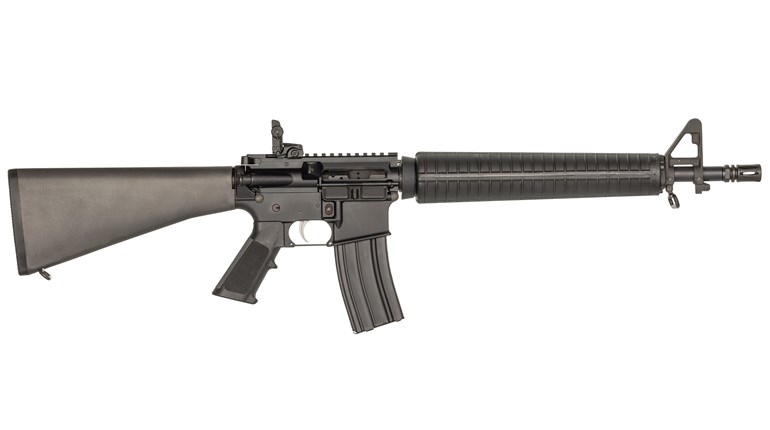
If Darwin were around today, no doubt he would be fascinated by the AR platform. Chuck was, after all, a gun guy (according to his autobiography, he shot quite a bit during his Cambridge days), and the AR has undergone enough evolutionary changes in the past decade to make his head spin.
But unlike Darwin's famous finches, ARs of course haven't changed by themselves over time. It has taken forward-thinking engineers, designers and manufacturers to bring about the development of the species. Still, nothing short of remarkable is the number of current variations on this single platform—many of which, much like bird beaks, incorporate adaptations that overcome certain problems and excel at specific tasks.
Rock River Arms is one gunmaker not afraid of tweaking the AR to better meet specialized needs. Its line has evolved to include dozens of variants in several chamberings, but one in particular puts the company on the cutting edge of platform progress. The LAR-PDS Carbine combines a gas-piston operating system with a side-folding buttstock and a forward-mounted charging handle, while retaining the familiar AR form and balance. The result is a unique set of features that answers many of the criticisms thrown at Eugene Stoner's design during the last 50-some years and shows just how adaptable the platform can be.
For more pictures of the LAR-PDS Carbine, click here.
Different Stroke
The PDS portion of the carbine's name refers to Rock River's Piston Driven System, a simple way of describing the clever short-stroke gas-piston operating mechanism that gives the gun several of its key characteristics. Being a gas-piston gun, the PDS Carbine has no gas tube running above the barrel and no gas key doglegging from the bolt carrier. The gas tube is replaced by a stout piece of steel bolted, staked and mechanically locked to the top of the carrier.
This rigid, but hollow, steel arm extends nearly 9 inches in front of the carrier, running parallel to the carbine's barrel and serving as both an operating rod and a housing for an action-spring/guide-rod assembly. The action spring and guide rod run through the entire length of the housing and emerge from their channel at the rear of the component, forming a tail that continues about 4.25 inches beyond the end of the carrier. The guide rod ends in a tapered base that locks into a recess at the rear of the upper receiver and is secured by a vertical roll pin.
A rectangular block that brackets the barrel forward of the handguard contains the piston and a two-position regulator. When the PDS Carbine is fired, propellant gases bled from the barrel pass through the port in the regulator and drive the piston a short distance rearward. The piston travels only about half an inch before it contacts the operating rod above the barrel, but pressure from the expanding gases gives it tremendous force. That stout little chunk of stainless steel shoves the operating rod and attached bolt-carrier assembly to the rear of the upper receiver, unlocking the bolt from the barrel extension and extracting the fired case.
As the operating rod travels rearward, it bears on a washer surrounding the stationary guide rod and compresses the action spring. The operating rod and bolt carrier come to an abrupt halt when the latter meets the rebound buffer, a thermoplastic washer residing at the rear of the lower receiver. Tension in the action spring takes over next, sending the bolt-carrier assembly and operating rod back toward the front of the receiver as it uncompresses, chambering a round from the magazine and readying the system for firing.
Fold 'Em
The PDS allows the carbine to have several characteristics not typically found on the AR platform—features that are often on critics' lists of missing essentials. For one, since the action spring is contained within the upper receiver, the PDS Carbine does not need a receiver extension to house a traditional buffer-and-spring assembly. Doing away with these components is further made possible by the carbine's stubby bolt carrier, which stops traveling rearward well short of where the lower receiver's end plate would normally reside. With no need for a fixed receiver extension to accommodate a recoiling carrier assembly or the means to return the bolt to lockup, the PDS Carbine can incorporate a side-folding buttstock.
While the PDS Carbine still utilizes a buffer tube, the part serves solely as a means for attaching a collapsible buttstock. There's nothing inside the tube and, in fact, it ends in a threaded cap that turns it into a storage compartment. Between the tube and the lower receiver is a spring-loaded hinge. Pulling up on the buttstock frees a robust tooth from its locked position and permits the stock to be folded along the left side of the carbine. The stiff hinge spring keeps the stock in place while it's folded. Rock River equips the PDS Carbine with its six-position Tactical CAR buttstock, but the hinge assembly includes an adapter that permits swapping it for other collapsible stocks.
Another notable feature of the PDS design is a forward-mounted, ambidextrous charging handle. It consists of a shallow U-shaped frame that slides along the upper receiver between the top rail and the barrel. Finger tabs on either side of the frame serve as grasping levers, which fold to the front when not in use.
The charging handle bears on the face of the operating rod, but since it's independent and shaped to provide clearance for the piston, it is non-reciprocating. The charging handle pushes the operating rod and bolt-carrier assembly to the rear when manually operated, but it does not cycle with the operating rod when the carbine is fired. The charging handle does not serve as a forward assist.
To permit the charging handle to slide freely along the upper receiver, Rock River devised a specialized system for attaching the PDS Carbine's one-piece handguard. Rather than forming a cylinder that surrounds the barrel, the handguard leaves the top of the barrel exposed. This creates a gap between the barrel and the upper receiver's extended top rail in which the charging handle can move.
Four screws secure the handguard to two brackets pinned in place on the barrel. The handguard makes no direct contact with the barrel nut or the barrel itself, but keep in mind the brackets do. While weight from accessories is an unlikely issue with the injection-molded handguard, it may be possible to mount enough add-ons to the optional PDS tri-rail handguard that barrel harmonics are affected, changing point of impact.
Easy Running
I'm not exactly enthralled with the position of the charging handle on conventional AR-platform rifles. Yes, I've grown accustomed to the awkward arm and wrist contortions sometimes required to clear stoppages and make the gun run, but that doesn't mean I have to like them. As such, I looked forward to getting my sample PDS Carbine on the range.
Nestled behind the gun in the prone position, I wasn't disappointed. It was just plain easier to run the gun with the charging handle out in front. The same was true when running offhand drills while standing and kneeling. If I wanted to lock back the bolt, I trapped the buttstock between my strong-side bicep and rib cage, rolled my firing hand under the lower receiver to press the bolt catch and pulled back on the charging handle with my support hand. Unlike with traditional ARs, I didn't feel like I was trying to punch myself in the chin.
There has been much talk about the "inherent inaccuracy" of gas-piston guns, but I didn't see anything to that effect with the PDS Carbine. It produced sub-MOA groups with the four loads I tested and an overall five-shot group average of 1.06 inches at 100 yards. It has been quite a while since I've had the pleasure of shooting a factory AR—gas piston or gas impingement—that accurate.
One word of caution: The regulator housing has a short section of Picatinny rail. It's just the ticket for mounting a tiny laser sight or a sling swivel. I, however, threw a Versa-Pod on it. During rapid-fire drills from prone, I noticed groups would widen and point of impact would shift a couple inches depending on how much forward pressure I put on the bipod.
The PDS Carbine ran smoothly without a single malfunction in more than 400 rounds. Recoil felt a bit sharper than what I'm used to with a direct-gas-impingement gun, but I'll take that trade-off for easier operation. Clean-up, as expected, was a snap. Besides some fouling around the piston and in the bore, of course, the gun looked about as clean as when I started my range session.
The LAR-PDS Carbine has a lot of neat things going for it, but one downside is the regulator is not tuned for use with a suppressor. Rock River is working on fixing that. And progress, or perhaps evolution, continues.
Manufacturer: Rock River Arms; (866) 980-7625
Action Type: Gas-piston-operated, semi-automatic
Caliber: 5.56 NATO
Capacity: 30 rounds
Receivers: Forged, 7075-T6 aluminum-alloy
Barrel: 4140 chrome-moly steel; 16 inches
Rifling: 6 grooves; 1:9-inch RH twist
Trigger Pull Weight: 2 pounds, 4 ounces, first stage; 4 pounds, 8 ounces, second stage
Sights: None; uninterrupted, full-length Picatinny rail for mounting iron sights and optics
Stock: Side-folding, 6-position Tactical CAR with storage compartment
Length: 34.5 to 37.75 inches, stock unfolded; 26 inches, stock folded
Weight: 7 pounds, 6 ounces
Accessories: Hard case, owner's manual
MSRP: $1,685


